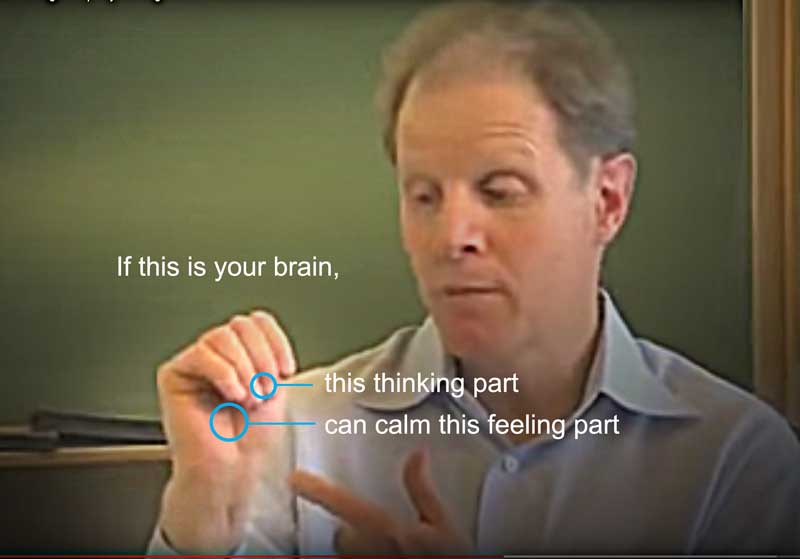No one likes to admit it. But even for the happiest of couples, anger sometimes gets the better of us. Partners have different ways of showing it. Some erupt in angry outbursts. Others withdraw into stony silence. Of course you and your partner don’t want to yell at each other, or fume behind icy walls of self-defense. But what else can you do?
The challenge of unresolved anger makes communicating with your partner so difficult. It’s not possible to truly understand each other when you feel attacked. And clamming up doesn’t help either. People don’t want to lose their temper, but if no one says anything, nothing gets resolved.
The good news is, anger is also a powerful agent of change.
Anger disturbs and disrupts our peace of mind so deeply, it compels us to do something about it! Partners can face anger in healthy ways, without attacking each other, or turning a cold shoulder.
Science is helping therapists, psychologists, and partners understand the biology of anger — and the calming power of relationships. Knowing how our bodies respond to anger — and can calm it — allow us to deal with anger successfully, and help relationships heal.
What Happens To Your Brain When You’re Angry?
When someone’s anger rages out of control, we might say the person “flipped their lid.” It turns out, this saying makes perfect sense, according to brain science.
Dr. Dan Siegel — who studies brain circuitry and its impact on our relationships and parenting — explains why.
Siegel uses a hand model to show how the brain’s parts work together to regulate each other, and create our states of mind. Image the brain as your open hand, palm out, fingers together. Your palm represents the basic control center for regulating the body, and the fight-flight-freeze response to danger. This is the brain stem.

Resting on top is the emotion center — the limbic system. It regulates memory, our feelings, and responds to relationships. By resting your thumb inward on your palm, you see how this limbic area sits on top of the brain stem, and gets direct input from it. These two areas respond to the body — to your heart pounding, for example, and input from your senses. These two areas play a big part in creating our emotional states. They give us impulses, instincts, quick reactions and what we do ‘automatically.’
Next, fold your four fingers over your thumb. This part represents the cortex (common to mammals) and — most important for soothing anger — the pre-frontal cortex, most developed in humans. Notice the area by your fingertips, from the last knuckle to the end of your fingers. It rests on the other two parts. This pre-frontal cortex is key to our ability to pause before acting on impulse.
Dr. Siegel explains: “The way it works is, there are fibers that come down from this middle pre-frontal area that actually calm down the irritable limbic area or brain stem area.”
So, the pre-frontal cortex, when it’s activated, allows us to stay calm when upset, ‘keep our heads’ under stress, and tune into the feelings of another person.
Sometimes, though, the brain stem and limbic system are so activated, they overpower the calming function of the pre-frontal cortex. Imagine flipping your four fingers up, as if the contact between your fingers and thumb suddenly broke off. That’s what happens when we ‘flip our lid. ‘
When the master regulator on top gets blown away, we say ‘something snaps.’ Brain science says we’re right. When emotions are too intense, the calming system shuts down, and our behavior can get out of control.
So, when we flip our lids, we lose emotional balance. This gives partners an important moment of choice when they find an argument heating up. They can press on, or pause before it’s too late.
How Can Partners Soothe Anger?
There’s another reason to pause as an argument heats up.
Another exciting finding shows that empathy, compassion and attunement can help one person calm another person. We’re learning that our brains can help trigger the calming response in another. This calming effect is more likely when two people can connect and tune into each other’s emotions.
How can partners learn to calm anger together?
We know that when we feel understood, we feel calmer.
When another person — especially a loved one — listens and tunes into their partner, they can help identify emotions and name them accurately. This re-engages the brain’s calming response and soothe the upset emotional state in the distressed partner.
Name It to Tame It
Dr. Siegel suggests this skill to calm upset feelings: “Name it to tame it.”
When one person is able to help another put their feelings into words, Dr. Siegel’s research saw the release of soothing neurotransmitters increase in the upset person’s brain. Emotional connection helps the brain restore the calming function of the pre-frontal cortex. This way, connection helps us find emotional balance, and build empathy and compassion with each other.
Though Dr. Siegel uses “name it to tame it” to help parents calm children, it works for any age — adult couples too.
When one partner can helps the other identify what’s upsetting, the calming pre-frontal cortex releases chemicals that reduce the fight-flight response. We may not know we can turn up our capacity for empathy and listening. But we can.
Mindfulness practices, such as meditation, yoga or deep breathing help activate the pre-frontal cortex. In other words, we can become more able to respond in new, calmer ways to the body’s distress signals. We can learn to calm them in ourselves, and then help calm them in each other.
Responding To Your Partner’s Emotional SOS
Anger is one feeling that tends to bubble to the surface first, especially in individuals not yet skilled in identifying their emotions. I call this an “SOS Feeling.” It signals one partner is having trouble managing something upsetting. It’s an opportunity for the other to help.
Other SOS feelings may include frustration, sadness, fear, distrust, and resentment.
What is going on to trigger these feelings? It helps to remember that emotions reflect a deeper layer of distress — a sense of danger, fear, loneliness, or hurt.
We may get angry, we may lose our temper and yell, but what’s going on under the anger? Is it fear of not being important, not being loved, or the terrible loneliness of missing being together?
How to Understand Angry Feelings
Yes, anger can be scary. But what if you could calm the anger, and look below it to see what is really troubling your partner?
When you and your partner are able to find empathy in tough situations, you find that your bond can grow and your emotional connection deepen despite the original intense feeling. Anger does not have to get in the way of your togetherness as a couple.
As unwelcome as it is, anger need not destroy your love. Understood, it can help you both make healthy changes. Instead of fighting it, running from it or fearing it, could you explore it?
If anger has overtaken your relationship, a professional therapist can help you both find a safe space to begin finding your way back to calm. Together, you can find a way to connect, stabilize and face emotions as partners, to help each other and your relationship.
We are here to help you. Please contact us to talk about how we might help.


